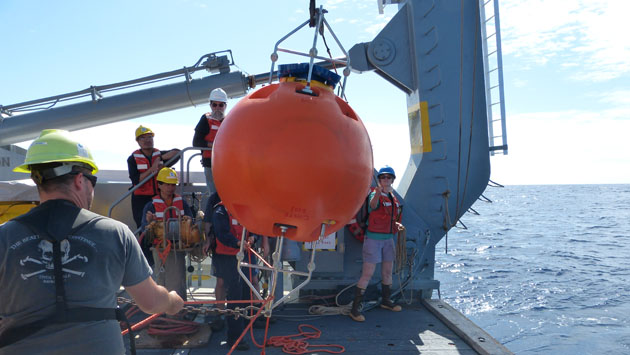Posted in:
Celebrating 35 Years of Particle Flux Measurements in the Sargasso Sea

Since 1978 the Oceanic Flux Program (OFP) has been studying particle fluxes in the deep Sargasso Sea. This year, the OFP celebrates 35 years of continuous measurements, making it the longest running time-series of its kind. “This is a monumental achievement for oceanography and for the US National Science Foundation, which supports the OFP. It is remarkable to look back at all we have learned about the workings of the deep ocean since the OFP began. And as we add ever more sophisticated instruments on the OFP mooring, it is really exciting to look forward to more discoveries about the deep,” says Dr. Maureen Conte, Associate Scientist at BIOS and Adjunct Scientist at the Marine Biological Laboratory Ecosystems Center in Woods Hole, Massachusetts.
Particle flux, also called the ocean’s “biological pump,” refers to the transfer of material from the surface to the deep ocean. These sinking particles carry with them many organic compounds and nutrients, some of which are dissolved and redistributed by ocean currents, and some that sink down through the water column. The organic material transported to depth is a crucial source of food for all life in waters deeper than about 150 meters. The residual fraction of material that makes it to the seafloor becomes buried in the sediments, allowing scientists to reconstruct the ocean’s history.
Dr. Conte, who has been leading the OFP since 1995, explains that studying how deep ocean particle flux varies over time, and in response to climatic forcings and changing ocean chemistry, helps scientists better understand ocean productivity, global cycles of elements, and the uptake of carbon dioxide from the atmosphere. “Particle flux is an essential process that regulates ocean health. Understanding the details of the particle cycle helps scientists better predict how the ocean will respond to our changing global climate,” she says.
The OFP study site is located 75 km southeast of Bermuda, in proximity to the Bermuda Atlantic Time-series Study (BATS) deployment site, which—along with Hydrostation “S”—provides ancillary data that helps OFP scientists better characterize how the deep particle flux patterns are linked with upper ocean processes and climate.
Recent OFP studies have found that changes in the magnitude and composition of the particle flux with depth is closely controlled by the midwater ecosystems. It appears that the changing food quality of the deep flux affects the intensity of zooplankton feeding. This, in turn, affects the “re-packaging” of small particles in suspension into large particles that then become part of the sinking flux. Putting it in layman’s terms, Dr. Conte says that, “We are indebted to these microscopic animals for helping to keep our ocean waters clean.”
For the past five years the OFP has also provided students in the Center of Excellence in Observational Oceanography (CofE) program with opportunities to participate in a research cruise aboard the R/V Atlantic Explorer. While aboard an OFP cruise, students learn about the engineering design of oceanographic moorings, scientific instrumentation used on moorings, and the essential ship equipment and seagoing skills that are required to safely recover and deploy deep ocean moorings.
Tagged:


